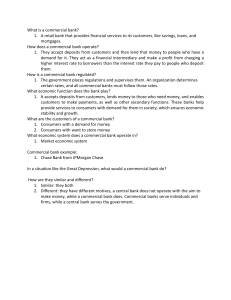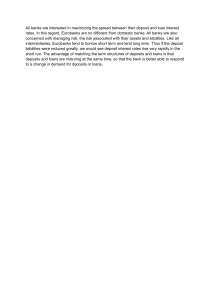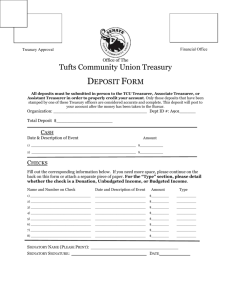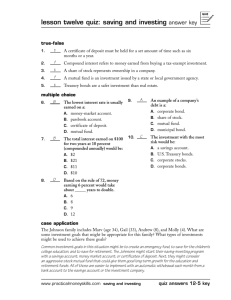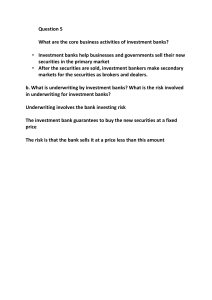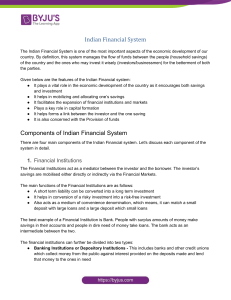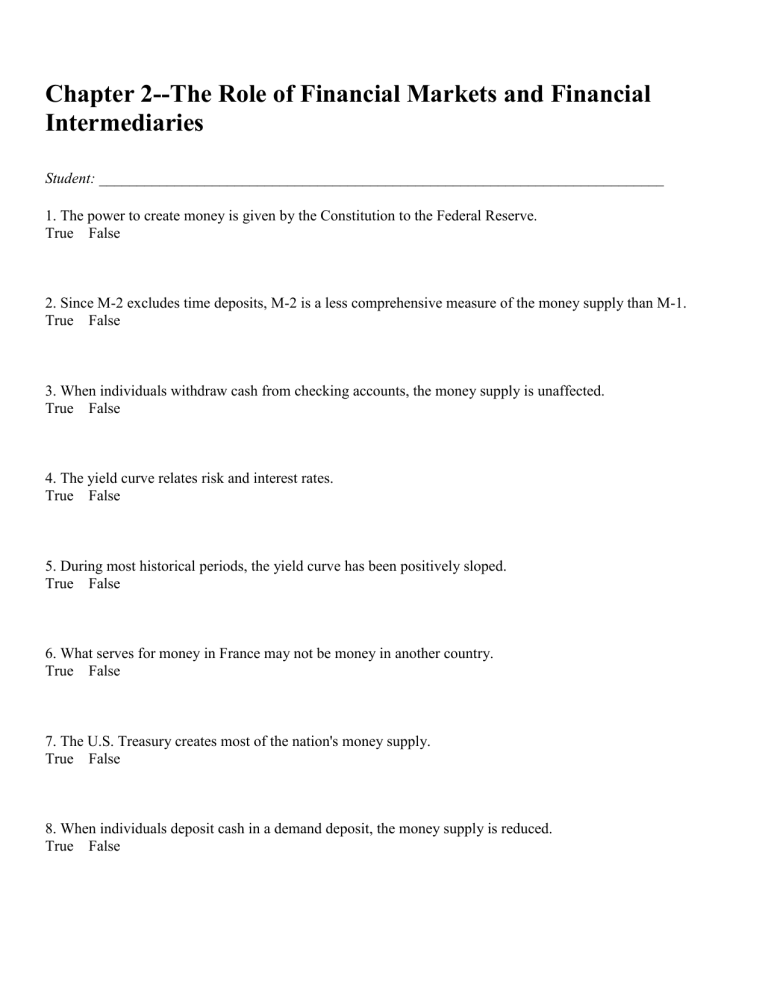
Chapter 2--The Role of Financial Markets and Financial Intermediaries Student: ___________________________________________________________________________ 1. The power to create money is given by the Constitution to the Federal Reserve. True False 2. Since M-2 excludes time deposits, M-2 is a less comprehensive measure of the money supply than M-1. True False 3. When individuals withdraw cash from checking accounts, the money supply is unaffected. True False 4. The yield curve relates risk and interest rates. True False 5. During most historical periods, the yield curve has been positively sloped. True False 6. What serves for money in France may not be money in another country. True False 7. The U.S. Treasury creates most of the nation's money supply. True False 8. When individuals deposit cash in a demand deposit, the money supply is reduced. True False 9. M-1 includes savings accounts in commercial banks. True False 10. A financial intermediary transfers funds from borrowers to lenders by creating claims on itself. True False 11. When cash is deposited in a checking account, the reserves of commercial banks are increased. True False 12. When funds are deposited in a savings account, the excess reserves of banks are unaffected. True False 13. Large certificates of deposit in units of $500,000 are insured by FDIC. True False 14. In general, banks prefer loans that stress liquidity and safety. True False 15. Insurance companies are a major source of loans to individuals. True False 16. Money market mutual funds invest in short-term securities like U.S. Treasury bills. True False 17. An increase in interest rates tends to reduce the earnings of money market mutual funds. True False 18. A pension plan that invests in the stock of IBM or Verizon does not perform the function of a financial intermediary. True False 19. Investments in money market mutual funds are insured up to $100,000 by the federal government. True False 20. A financial intermediary creates claims on itself, when it accepts depositors' funds. True False 21. M-1 includes coins, currency, and ____. A. demand deposits B. savings accounts C. certificates of deposit D. time deposits 22. The power to create money is given by the Constitution to A. state governments B. Congress C. the Federal Reserve D. commercial banks 23. The term structure of interest rates relates A. risk and yields B. yields and credit ratings C. term and yields D. stock and bond yields 24. The term structure of interest rates indicates the A. relationship between risk and yields B. relationship between the time and yields C. the difference between borrowing and lending D. the difference between the yield (interest rate) on government and corporate debt 25. Money serves as A. a substitute for equity B. a precaution against inflation C. a medium of exchange D. a risk-free liability 26. M-2 includes 1. 2. 3. demand deposits savings accounts small certificates of deposit A. 1 and 2 B. 2 and 3 C. 1 and 3 D. all three 27. Which of the following is not a financial intermediary? A. New York Stock Exchange B. Washington Savings and Loan C. First National City Bank D. Merchants Savings Bank 28. The assets of a typical commercial bank include A. commercial loans B. demand deposits C. common stock D. equity 29. Federally insured investments include A. savings accounts in national commercial banks B. certificates of deposit in excess of $500,000 C. life insurance policies D. commercial bank assets 30. The primary assets of life insurance companies include A. life insurance B. corporate securities C. municipal securities D. insurance policies 31. A pension plan that grants mortgage loans A. is an example of a financial intermediary B. cannot suffer losses C. is called a savings and loan association D. is not a financial intermediary 32. Money market mutual funds invest in A. corporate bonds B. corporate stock C. federal government Treasury bills D. federal government Treasury bonds 33. A financial intermediary transfers A. savings to households B. savings to borrowers C. stocks to brokers D. new stock issues to buyers 34. Treasury bills are A. long-term securities issued by the federal government B. short-term securities issued by the federal government C. long-term securities issued by money market mutual funds D. short-term securities issued by money market mutual funds Chapter 2--The Role of Financial Markets and Financial Intermediaries Key 1. The power to create money is given by the Constitution to the Federal Reserve. FALSE 2. Since M-2 excludes time deposits, M-2 is a less comprehensive measure of the money supply than M-1. FALSE 3. When individuals withdraw cash from checking accounts, the money supply is unaffected. TRUE 4. The yield curve relates risk and interest rates. FALSE 5. During most historical periods, the yield curve has been positively sloped. TRUE 6. What serves for money in France may not be money in another country. TRUE 7. The U.S. Treasury creates most of the nation's money supply. FALSE 8. When individuals deposit cash in a demand deposit, the money supply is reduced. FALSE 9. M-1 includes savings accounts in commercial banks. FALSE 10. A financial intermediary transfers funds from borrowers to lenders by creating claims on itself. FALSE 11. When cash is deposited in a checking account, the reserves of commercial banks are increased. TRUE 12. When funds are deposited in a savings account, the excess reserves of banks are unaffected. FALSE 13. Large certificates of deposit in units of $500,000 are insured by FDIC. FALSE 14. In general, banks prefer loans that stress liquidity and safety. TRUE 15. Insurance companies are a major source of loans to individuals. FALSE 16. Money market mutual funds invest in short-term securities like U.S. Treasury bills. TRUE 17. An increase in interest rates tends to reduce the earnings of money market mutual funds. FALSE 18. A pension plan that invests in the stock of IBM or Verizon does not perform the function of a financial intermediary. TRUE 19. Investments in money market mutual funds are insured up to $100,000 by the federal government. FALSE 20. A financial intermediary creates claims on itself, when it accepts depositors' funds. TRUE 21. M-1 includes coins, currency, and ____. A. demand deposits B. savings accounts C. certificates of deposit D. time deposits 22. The power to create money is given by the Constitution to A. state governments B. Congress C. the Federal Reserve D. commercial banks 23. The term structure of interest rates relates A. risk and yields B. yields and credit ratings C. term and yields D. stock and bond yields 24. The term structure of interest rates indicates the A. relationship between risk and yields B. relationship between the time and yields C. the difference between borrowing and lending D. the difference between the yield (interest rate) on government and corporate debt 25. Money serves as A. a substitute for equity B. a precaution against inflation C. a medium of exchange D. a risk-free liability 26. M-2 includes 1. 2. 3. demand deposits savings accounts small certificates of deposit A. 1 and 2 B. 2 and 3 C. 1 and 3 D. all three 27. Which of the following is not a financial intermediary? A. New York Stock Exchange B. Washington Savings and Loan C. First National City Bank D. Merchants Savings Bank 28. The assets of a typical commercial bank include A. commercial loans B. demand deposits C. common stock D. equity 29. Federally insured investments include A. savings accounts in national commercial banks B. certificates of deposit in excess of $500,000 C. life insurance policies D. commercial bank assets 30. The primary assets of life insurance companies include A. life insurance B. corporate securities C. municipal securities D. insurance policies 31. A pension plan that grants mortgage loans A. is an example of a financial intermediary B. cannot suffer losses C. is called a savings and loan association D. is not a financial intermediary 32. Money market mutual funds invest in A. corporate bonds B. corporate stock C. federal government Treasury bills D. federal government Treasury bonds 33. A financial intermediary transfers A. savings to households B. savings to borrowers C. stocks to brokers D. new stock issues to buyers 34. Treasury bills are A. long-term securities issued by the federal government B. short-term securities issued by the federal government C. long-term securities issued by money market mutual funds D. short-term securities issued by money market mutual funds
